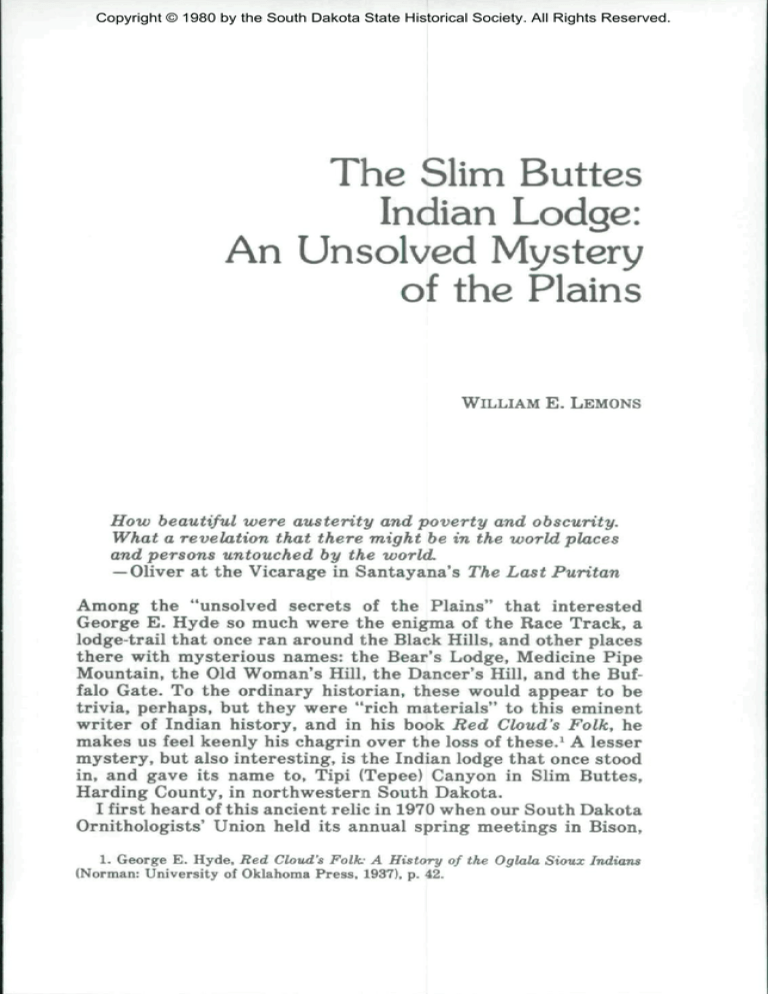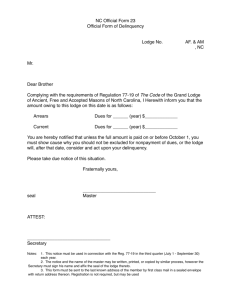
Copyright © 1980 by the South Dakota State Historical Society. All Rights Reserved.
The Slim Buttes
Indian Lodge:
An Unsolved Mystery
of the Plains
WILLIAM E . LEMONS
How beautiful were austerity and poverty and obscurity.
What a revelation that there might be in the world places
and persons untouched by the world.
— Oliver at the Vicarage in Santayana's The Last Puritan
Among the "unsolved secrets of the Plains" that interested
George E. Hyde so much were the enigma of the Race Track, a
lodge-trail that once ran around the Black Hills, and other places
there with mysterious names: the Bear's Lodge, Medicine Pipe
Mountain, the Old Woman's Hill, the Dancer's Hill, and the Buffalo Gate. To the ordinary historian, these would appear to be
trivia, perhaps, but they were "rich materials" to this eminent
writer of Indian history, and in his book Red Cloud's Folk, he
makes us feel keenly his chagrin over the loss of these.' A lesser
mystery, but also interesting, is the Indian lodge that once stood
in, and gave its name to, Tipi (Tepee) Canyon in Slim Buttes,
Harding County, in northwestern South Dakota.
I first heard of this ancient relic in 1970 when our South Dakota
Ornithologists' Union held its annual spring meetings in Bison,
1. George E. Hyde, Red Cloud's Folk- A History of the Oglala Sioux Indians
(Norman: University of Oklahoma Press, 1937), p. 42.
Copyright © 1980 by the South Dakota State Historical Society. All Rights Reserved.
1S4
South Dakota History
not far from Slim Buttes. Although he had never seen it and did
not know much about it, our host, Alfred Hinds of Sorum, told me
of an old Indian tipi that was still standing in a Slim Buttes canyon, guarded over the long years, rather secretly, he intimated,
by a nearby rancher. I knew of the Battle of Slim Buttes that took
place on 9 and 10 September 1876 between General George
Crook's army and a small village of Sioux, and at first, I assumed
some connection between the battle and the old lodge. One tipi
had actually survived the destruction that followed the
fight —the famous Buckskin Lodge at Slim Buttes that became
Captain Anson Mills's trophy, two photographs of which exist,
taken by Stanley J. Morrow.^ Perhaps here was another grim
reminder of that sad conflict and one that might afford me a faint
2. J. W. Vaughn, Indian Fights: New Facts on Seven Encounters (Norman:
University of Oklahoma Press, 1966). chap. 7.
Stanley J. Morrow photograph showing "Prisoners captured at
Slim, Buttes with captors —Custer's battle flag and buckskin lodge
as trophies. " Taken after the 1876 Battle of Slim Buttes, the photograph
is part of the W. H. Over Museum's Morrow collection in Verm.illio7L
Copyright © 1980 by the South Dakota State Historical Society. All Rights Reserved.
Slim Buttes Indian Lodge
135
scent of that great Plains Indian buffalo-hunting culture. The
possibility gripped my imagination.
When Alfred and Gertrice Hinds again invited our group of
birders to Bison for the weekend beginning 20 May 1977, I was
determined to find the lodge if I could. A friend, Willis Hall of
Yankton, was also anxious to see it, I drove early to Bison in
order to have extra time for the search, but a heavy rain made
Tipi Canyon inaccessible for two days. While waiting for the trail
to dry out, I talked with some lifelong residents of the region
about the tipi: Bob and Frieda Elling at their store in Reva. John
W. Helms, whose ranch is near the canyon.^ and later, accompanied by Willis after he arrived, Ray Estherich. I found that I
had erred in my suppositions (except for my approximate dating
of the lodge): the battle had taken place on the east slope of Slim
Buttes and the lodge Mr. Hinds had spoken of was on the west
slope; the tipi had probably not been a hide tipi but another kind;
and it was not necessarily Sioux, nor even Indian, for both Mr.
Elling and Estherich thought the structure might have been built
as a hideaway by a white outlaw. Somewhat disappointed, we
spent an afternoon (in the rain) exploring the battlefield, and I
finally had the satisfaction of locating the ravine (marked as a
state historical site) where American Horse surrendered, along
with two men, twelve women, six children, and an infant, after
one man, three women, and a baby had been killed there and he
himself mortally wounded. I had studied and pondered the events
of the Sioux war of 1876 so long that actually seeing this place
almost became a melancholy experience of paramnesia for me.
The chief had marched "out of that deathtrap as straight as an
arrow," according to Frank Grouard,* though holding his protruding intestines in his hands. He died that night, attended by
Crook's surgeon Dr. Valentine T. McGillycuddy, the famous Pine
Ridge Indian agent of later years.^
On Saturday morning, Willis and I went to the Helms ranch,
where Laverne Helms graciously told us how to find the lodge. In
Willis's Volvo wagon, we then drove a few miles across the ranch
3. For their help. I wish to thank not only Mr. Helms and his wife Laverne but
also their daughter and sons. Heather. John, Lynn, Scott, Gordon, and Gordon's
wife Sandi.
4. Joe DeBarthe. Life and Adventures of Frank Grouard, ed. Edgar I, Stewart
(Norman: University of Oklahoma Press, 1958), p. 158.
5. John F. Finerty. War-Path and Bivouac; or. The Conquest of the Sioux (1^90',
reprint ed., Norman: University of Oklahoma Press, 1961). p. 198.
Copyright © 1980 by the South Dakota State Historical Society. All Rights Reserved.
1S6
South Dakota History
and up a rough and steep trail as far as we could go. The rest of
the way we hiked, climbing higher and higher, until we reached a
grassy plateau. It was exciting country. The so-called Slim Buttes
are rocky outcroppings rising three to four hundred feet above
rolling savannahs in a north-south formation resembling a great
L that is about eighteen miles long and from half a mile to three
miles wide. As I viewed these lofty buttes, consisting of tier on
tier of sheer shale and sandstone escarpments with sloping
masses of debris at their bottoms and here and there a ponderosa
pine valley, I thought of John F. Finerty, the fearless Irish newspaperman accompanying the Crook expedition of 1876, and his
comparison of them with "a series of mammoth Norman castles."*"
Along the way. we recorded all bird species we saw, including a
flock of eleven wild turkeys. Having been warned that this was
rattlesnake country, I could not help watching where I stepped,
even though I had long been mindful, and appreciative too, of
what J. Frank Dobie once wrote, that rattlesnakes "make the
country more interesting and natural" and that he hated to imagine the time when they would be gone.^ Willis, however, always
strode ahead heedlessly, making me a little ashamed of my caution. On this plateau, with its high view of the surrounding
countryside, we explored many miles of terrain but could not find
the landmarks that would lead us into the canyon where the lodge
was. Finally, we decided to return to the ranch and obtain further
information from Mrs. Helms. Our second attempt was successful.
We followed the southern edge of the plateau downward into a
large draw (Tipi Canyon), which begins at the top of a butte rising
high above the plains and which descends in a northwestern
direction. Ascending the draw, we passed a spring and then about
one hundred fifty feet south suddenly came upon the old lodge in
an aspen grove on the east side of the canyon's floor near the
upper end. The structure had collapsed, and the aspen poles that
had once leaned upright in the conical shape of a tipi now
resembled a large pile of firewood.
We stared at it in silence. Its wild and secret realm, darkened
by dense trees and heavy brush above and on all sides, so far
away from everything familiar to us, seemed eerily remote. A
world within itself, it was, complete and self-sufficient, outside
history, without any dependency upon the vast industrial civiliza6. Ibid.. p. 194.
7. J. Frank Dobie, Rattlesnakes (Boston: Little. Brown & Co.. 1965). p. 152.
Copyright © 1980 by the South Dakota State Historical Society. All Rights Reserved.
Resembling "mammoth Norman castles," the hard clay outcroppings of the
Slim Buttes area are typified by this photograph of Battleship Rock near Reva.
tion that lay beyond the grassy plains below, where the buffalo
had bellowed and gored long before. It was a reminder of what
Audubon once said, that there is "nothing perfect but primitiveness," though it also possessed a kind of extra dimension because
of its evidence of solitary human habitation. Willis remarked that
he would like to stay there the rest of his life, and I understood.
We walked around the old lodge respectfully, not disturbing any
of its remains, and Willis photographed it. As we left, three blacktailed deer jumped up before us in a thicket.
When I returned to Vermillion, I began to look into the history
of the old lodge. I soon found some references to it in library
materials, though none in the South Dakota Historical Collections, and Will Robinson himself seemed unaware of its existence
for some reason when he made his 1956 tour of Slim Buttes,
although his guide was Ray Estherich, one of our informants
Copyright © 1980 by the South Dakota State Historical Society. All Rights Reserved.
138
South Dakota History
about the lodge." June Sampson, director of the W. H. Over
Museum at the University of South Dakota, found two good
photographs of it, taken when its structure was still intact, and
also one of a remarkably similar lodge in the Owl Creek Mountains of Wyoming. In fact, I gradually learned that the Slim
Buttes lodge, called "conical timbered lodge" by anthropologists
and archaeologists {who have an amusing penchant for coining
abstract names, e.g., George A. Pettit's term for Indian medicine
men is "extramundane intercessors"), was a common type of
dwelling used by numerous Indian tribes in Montana, Wyoming,
the western Dakotas, and other states adjacent to these. Eventually, I obtained a full report on the Slim Buttes lodge done in
1967 and learned that it had been assigned a number (39HN201) in
the national register of archaeological sites.' Much later still, I
discovered a master's thesis on the subject by Arthur Spalding
Kidwell, Jr., which locates forty-seven such structures that are
either still standing or described in documents.^° More are still
being found today.
According to Kidwell, the conical timbered lodge of the northwestern plains (not the same as the smaller, crude "wickiup" or
brush shelter of the Great Basin) was made of as many as one hundred thirty poles (preferably aspen or pine but sometimes ash) up
to twenty-five feet in length and with a diameter of one inch to a
foot, leaning closely together against a three- or four-pole foundation cluster, which was sometimes lashed at the top but more
often locked together by means of the forked pole ends. The
structure was usually self-supporting but was sometimes built
against a ledge or around or against a tree. The poles were
covered with bark and green boughs, while those lodges on the
eastern edge of the plains area were banked with earth as well.
The wall was carefully fashioned so that no firelight could shine
8. See "Slim Buttes: Little Known Wonder Region," Wi-Iyohi 10 (1 Dec.
1956):l-8.
9. Stuart W. Conner and Samuel D. Halverson, "Slim Buttes Lodge," Archaeology in Montana 10, nos. 1-2 (1968):1-13.1 am much indebted to Robert Alex, State
Archaeologist of South Dakota, for sending me a copy of Halverson's report to
Conner and of the publication draft of Conner's article, as well as copies of other
articles. Halverson, United States Forestry Service ranger of the Custer National
Forest, did the local investigation of the lodge site and its history, and Conner provided the scholarship on the subject, interpreted the data, and wrote the article.
10. Arthur Spalding Kidwell, Jr., "The Conical Timbered Lodge on the Northwestern Plains: Historical, Ethnological, and Archaeological Evidence," Archaeology in Montarta 10. no. 4 (1969):l-49. I am grateful to Stuart W. Conner for calling
my attention to this work and for loaning me a copy of it.
Copyright © 1980 by the South Dakota State Historical Society. All Rights Reserved.
Slim Buttes Indian Lodge
139
through it. The floor diameter was fourteen feet or more, and the
entrance was an inverted V-shaped opening in the poles, usually
facing south or east away from the prevailing winds. In outline,
the structure resembled, therefore, the Plains Indian tipi but was
smaller and without any cover of hides. Those tribes using a
three-pole (e.g., the Sioux) or four-pole (e.g., the Crows) foundation in their hide tipis probably used the same in their timbered
lodges. These lodges were always well concealed and usually
close to water. Commonly, they had interior fire hearths, and
some had exterior ones also. One structure per site was normal,
but two or three at the same site have been recorded. The dating
of these dwellings is difficult, but probably those known to us today were built "no earlier than 1800 and most likely . . . thirty or
more years later."" Almost all of the northwestern plains tribes
used conical timbered lodges, although a few of the more western
groups preferred a log cabin or "cribbed" type made of horizontally laid logs with four or five sides. Some scanty evidence suggests that white trappers and other non-Indians sometimes used
these shelters and even built them when the need was great.
The role of these dwellings was not domestic. Generally, those
found on the eastern edge of the northwestern plains served as
winter hunting or eagle-trapping lodges (or as both), while those
farther west —the great majority —served as protective shelters
for war parties (and incidentally as havens for "visionaries and
elopers," i.e., eloping lovers"'). Both kinds of lodges were inhabited temporarily but may have been repaired and reused
many times. In 1871, Dr. Washington Matthews spent three
nights in a hunting lodge he stumbled upon in the Bad Lands of
the Little Missouri River. It was "quite old" and "had often
served as the temporary shelter of Hidatsa hunting parties." It
stood in an "excellent but dangerous game-region" four or five
days' travel from Fort Berthold.'^ Eagle-trapping lodges were
cleaned and repaired in the early fall and used year after year by
their tribal owners. Like the hunting and war lodges, they were
well hidden in timber groves near sources of fresh water; the pits
in which the eagles were caught were located on nearby high
bluffs."
11. Ibid., p. 26.
12. Ibid.. p. 18.
13. Washington Matthews, Ethnography and Philology of the Hidatsa Indians,
United States Geological and Geographical Survey. Miscellaneous Publications, no.
7 (Washington, D.C. 1877). p. 8.
14. Kidwell, "Conical Timbered Lodge." pp. 7-10.
Copyright © 1980 by the South Dakota State Historical Society. All Rights Reserved.
Undated ph'tnqr:¡i:h ni'ih--' lodgf. takin hij W. H. Over,
showing the \ shaped opening of the structure.
The conical timbered lodge was also "ideally suited" for traveling war parties, in the judgment of Kidwell and others, because it
was simple in design and easy to build, though strong and lasting.
Hence, the name sometimes applied to it is Indian fort; as Wolf
Chief told Gilbert L. Wilson, even though he was referring to his
party's eagle-trapping lodge that they feared might be attacked.
Copyright © 1980 by the South Dakota State Historical Society. All Rights Reserved.
Slim Buttes Indian Lodge
HI
"A hunting lodge was built strongly and served as a kind of
fort."'^ Ten warriors could build one in two hours —a great advantage since war lodges were customarily erected in dangerous territory near the enemy camps. On horse raids, the timbered lodge
was especially convenient. Besides offering protection from the
bad weather of late fall or winter and some rugged defensive
shelter in case of a surprise attack, it could be used as a base
camp and rendezvous by scouts advancing ahead of a party to
locate the enemy and as a supply dump for the return trip by the
party itself. It could even serve as an "information station" or
contact point for separated members of the group when
homeward-bound after the foray.'*"
The Slim Buttes lodge fits well the typical pattern of most
other conical timbered lodges described by Kidwell. Made of two
layers of aspen poles with "grass and shrubs" between them, it
was thoroughly concealed in a wooded canyon near not one, but
two, springs." It had a V-shaped doorway facing south and had
both an inside and outside fireplace. Apparently, it had an anchor
timber, heavier than the other poles, as a brace in the rear. It was
made of from fifty to sixty poles that were twelve to fourteen feet
long in 1910 and was about eight feet tall at that time with a circumference of forty-four feet and a diameter of fourteen feet. Its
interior height could accommodate five grown men standing
erect. Obviously, both the height and diameter of the lodge had
been diminished over the years by the decay and settling of the
pole ends. A "circular ring of irregularly shaped cubical rocks
ranging in size from five inches in diameter to a few larger ones
about 12 inches in diameter" extended around the structure —
presumably a device to hold in place the butt ends of the poles.
This rock ring is a variant in design known for no other lodge.'"
This lodge was first found by a non-Indian during the winter of
1886. when mustanger and former buffalo skinner Bill Rumbaugh
chanced upon it while he was riding through what later came to
15. Gilbert Livingstone Wilson. Hidatsa Eagle Trapping, Anthropological
Papers of the American Museum of Natural History, vol. 30. pt. 4 (New York. 1928).
p. 127.
16. Kidwell, "Conical Timbered Lodge," pp. 13-19.
17. The closer of the two springs, about seventy-five feet north of the lodge, has
since dried up (Conner and Halverson. "Slim Buttes Lodge." p. 2).
18. Conner and Halverson, "Slim Buttes Lodge," pp. 1-5. Kidwell was unaware of
the rock ring, having seen only Halverson's preliminary report to Conner, but
Conner and Halverson state in their article that "none in Montana has the rock ring
that appears at the Slim Buttes lodge" (p. 8). Kidwell reports none for lodges in
other states.
Copyright © 1980 by the South Dakota State Historical Society. All Rights Reserved.
142
South Dakota History
be known as Tipi Canyon. Rumbaugh worked at the time on the
Abe Jones ranch east of SUm Buttes. When Ralph E. Waugh arrived in Harding County in 1910 to take up ranching, he heard
Rumbaugh tell of his find. Rumbaugh said that the lodge looked
five or six years old when he first saw it. Waugh took a lively interest in the lodge and "zealously guarded" it for over fifty years,
replacing its poles when they fell. He was Halverson's informant
in 1967.'" His death in 1973 left the lodge untended, we must
assume, and it collapsed; hence its condition when we visited it in
1977.
Another lodge in Tipi Canyon of about the same age was
sighted, photographed, and reported in 1909 by George F. Will,
well known in the Dakotas as a semi-professional anthropologist
and historian, as well as a botanist and experimenter with Indian
plants, who was president of the North Dakota State Historical
Society from 1942 till 1955. It was similar to Waugh's lodge —
indeed, the identity of the two has been confused —but Will's was
banked with earth, had an excavated floor, and contained a buffalo skull that had evidently once been painted in colors.^" Apparently, this lodge no longer survives. Both Kidwell and Conner
think that Will's lodge was a Mandan-Hidatsa eagle-trapping
lodge because of the grass and mud covering and the excavated
floor^' (i.e., excavated when the lodge was built).
But even better evidence of the function of Will's lodge was the
presence of the painted buffalo skull, a sacred object which
served as the central shrine during the elaborate Hidatsa eagletrapping ceremonies described by Wolf Chief for Wilson in 1915.
Other sacred objects were laid upon the buffalo skull during
these rituals. It was carefully placed at certain times so that its
"eyes" looked in appropriate directions; it received constant, holy
deference from the leader and his assistants, who addressed it as
a godlike being, passed by it only in prescribed ways, and stood
before it with offerings while singing or smoking the pipe." The
primacy of this buffalo skull symbol derived from an ancient
tradition that the Hidatsa had originally obtained their eaglecatching ceremonies from the black bears, who used them with
great success in their own eagle hunts, and "when the black bears
19. Ibid., p. 1.
20. George F. Will, "Some Observations Made in Northwestern South Dakota,"
American Anthropologist 2. no. 2 (1909):257-65.
21. Kidwell, "Conical Timbered Lodge," p. 12; Conner and Halverson, "Slim
Buttes Lodge," p. 12.
22. Wilson, Hidatsa Eagle Trapping, pp. 145-56.
Copyright © 1980 by the South Dakota State Historical Society. All Rights Reserved.
Slim Buttes Indian Lodge
Slim Buttes Lodge in Tipi Canyon, photographed by Joan Jensen
of Sorum in 1938, when the lodge was being watched over by
William Waugh (boy with horse is unidentified}.
gave [an eagle-trapping] ceremony, the leaders were always buffaloes who gave themselves to be used for food by the [human]
people, a kind of present to the people from the black bears.""
23. Ibid., p. 158.
Copyright © 1980 by the South Dakota State Historical Society. All Rights Reserved.
South Dakota History
In his report of 1909, Will described two eagle-trapping pits he
saw on his visit to Slim Buttes, although he did not tell their locations, and Kidwell thinks that Waugh's lodge may have been used
by eagle trappers." Eagle hunting with the use of pits was practiced by many tribes. The above-mentioned Wolf Chiefs eagle
hunt took place in September 1864 on the north side of the Little
Missouri River thirty miles west of what was the settlement
called Independence before the Garrison Dam flooded the region.
Wolf Chief was fifteen at the time. His father. Small Ankle, who
"had great power in the black bears' prayers," directed all of the
activities. The party, consisting of two boys, ten men, and three
women, first rebuilt an old eagle-hunters' lodge they knew
existed in the locale. Then the lodge, "which we Hidatsa thought
of... as a living person," was sanctified by long and complex
ceremonies that lasted an afternoon and evening; the ceremonies
extended to the fireplace pit, some of the equipment to be used,
and the bait for luring the eagles to the pits as well. Offerings
were made to the eagle. Like other plains tribes, the Hidatsa venerated the eagle and believed in his mystery power. The ceremonies not only served the mundane purposes of protecting the
hunters from enemy attack and of providing them with buffalo
meat as food but were also intended to overcome the supernatural power of the eagle, thus reducing his fierceness and
making him gentle for easier taking."
On the days following the first ceremonies, the hunters
selected their pit sites (on the edge of a high bluff usually, facing
the west), dug them (long enough so that a man might lie down at
the pit's bottom, deep enough so that his head was not visible
when he sat up, and perhaps thirty or more inches wide), and
covered them with loosely woven stick-and-grass mats. The fresh
meat used as bait was placed on each mat and tied to a pin driven
into the west wall of the pit below. The hunting then began,
lasting four days during which the men would hunt in the daytime and return to the ceremonial lodge at night."
The hunter would lie down at the pit's bottom, wait for an eagle
to alight upon the bait, reach up and seize his legs, raising the pit
cover with his head, climb out of the pit, bind the bird's wings and
legs with a thong he carried in his belt, and pluck his twelve tail
feathers. Wailing and weeping, he would approach the ceremonial
24. Will. "Some Observations," p. 260; Kidwell, "Conical Timbered Lodge," p. 12.
25. Wilson. Hidatsa Eagle Trapping, pp. 142 58.
26. Ibid., p. 114; Matthews, Ethnography, pp. 59-60.
Copyright © 1980 by the South Dakota State Historical Society. All Rights Reserved.
The remains of Slim Buttes lodge, photographed by
Willis Hall of Yankton, May 1977.
Copyright © 1980 by the South Dakota State Historical Society. All Rights Reserved.
146
South Dakota History
lodge with his captive eagle, crying out his wish that this "god"
under his arm would help him capture many more eagles. After
the eagle was taken into the lodge, further detailed ceremonies
were executed that were repeated for each subsequent bird
brought in, the intention still being to destroy, or control, the
bird's sacred power lest it hurt the hunters in some way or cause
them to die. Then, at a propitious moment, the eagle was taken
outside —before he got "too heavy" (i.e., before the mystery
power of the lodge oppressed him and gave him a heavy
feeling)-and tethered by his left foot in a shelter behind the
lodge. Later, the captured eagles would be ceremonially released,
or sometimes they might be ceremonially "put to sleep" if their
wings had been taken for fans and plumed arrows."
In contrast to Kidwell, however, Conner believes that Waugh's
lodge in Slim Buttes was not an eagle-trapping one but a war
lodge, so located territorially as to have been used by any of the
roving Crow. Sioux. Cheyenne, or Arapaho war parties or even
by one from the Mandan, Hidatsa, or Arikara villages to the east
and north. He adds, however, that "because our knowledge of
Hidatsa war lodges is presently fragmentary, and of Hidatsa
winter camps is inadequate, the possibility cannot be ruled out
that the Slim Buttes lodge was either an Hidatsa war lodge or an
Hidatsa temporary winter lodge.""
It would be good to know, but all we may ever be able to do is
imagine, what fascinating rites or other dramatic happenings
took place in the lodge that Ralph Waugh saved for us in Tipi Canyon with such faithful dedication. Nevertheless, the state might
at least erect a historical marker before the site is lost, and an excavation by qualified anthropologists of the lodge's floor might
reveal the identity of its tribal builders and its original function,
although Kidwell says that few artifacts have ever been found at
the sites of conical timbered lodges.*^ The investigators might
also examine the nearby bluffs to see whether eagle-trapping pits
were there. All in all, while we know a great deal about the Plains
Indians, unsolved secrets like Slim Buttes lodge fascinate and
challenge us to learn more. While the lodge still exists, we should
do all we can to preserve it and uncover its story — for soon it will
be too late.
27. Wilson, Hidatsa Eagle Trapping, pp. 139, 169-74. 204.
28. Conner and Halverson, "Slim Buttes Lodge," pp. 14-15.
29. Kidwell. "Conical Timbered Lodge," p. 24.
Copyright © 1980 by the South Dakota State Historical Society. All Rights Reserved.
Copyright of South Dakota History is the property of South Dakota State Historical Society and its content may
not be copied or emailed to multiple sites or posted to a listserv without the copyright holder's express written
permission. However, users may print, download, or email articles for individual use.
All illustrations in this issue are the property of the South Dakota State Historical Society except those on the
following pages: p. 115, from Thomas D. Isern, Emporia, Kans.; pp. 121 and 131, from State Historical
Society of Wisconsin, Madison, Wis.; pp. 134, 140, and 143, from W. H. Over Museum, Vermillion; p. 137,
from South Dakota Division of Tourism, Pierre; p. 145, from Willis Hall, Yankton; and p. 176, from James
Pollock, Pierre.







